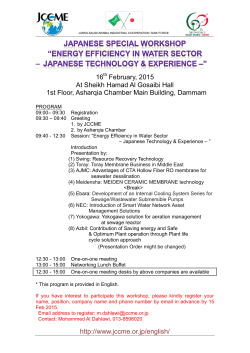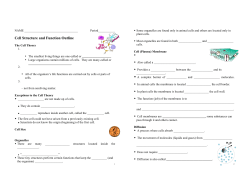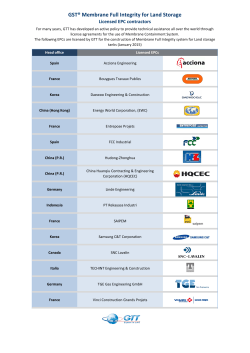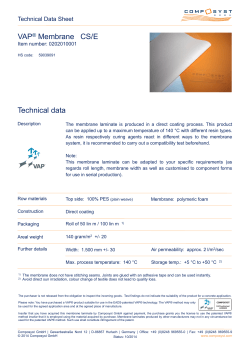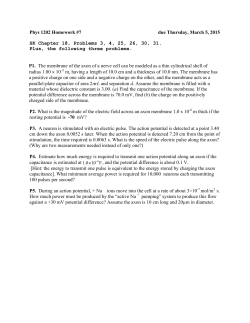
Alternative Ways to Processing Whey - Dairy Of India-2015
ALTERNATIVE WAYS TO PROCESSING WHEY Alternative Ways to Processing Whey Alok Chatterjee, S. K. Ka na wjia a nd Yogesh Khetra Cheese and Fermented Foods Lab, Dairy Technology Division, National dairy Research Institute Karnal-132001, Haryana Introduction Yeste ryears have witnessed significant potential of science in resurre cting whe y. Not too long back, whe y; the greenish colore d liquid discharge from manufacturing of various mainstream dairy products; was a potential threat to the e cology and problem to the industrial dispense be cause be ing high on biological ox yge n demand. But with science and te chnology inte rve ning, the bane turned itself into boon with te chnofunctional and biofunctional abilities. Give n the pe rsistent increase in demand of the products; i.e . chee se in prime; resulting in rising volum inous gene ration of whey, more growth in utilization of it is not only expe cte d but ine vitable too. Whe y processing and application today are yielding a wealth of quality products that are increasingly seen as ingre die nts in formulations that have re cognized positive health benefits (Onwulata. 2008). Due to the presence of scarce and indispensable am ino acids (lysine, tryptophane, me thionine , threonine and cyste in), whe y staffs itse lf as an ex tremely important by-product of dairy produce s (Kondratovych et al., 2013). Qualitative composition of amino acids present in whe y have confe rred various health be nefits and are pouring in reports and studies in scie ntific community. Innovative processing te chniques are ousting olde r me thods, yie lding products with be tte r applica bility. Bypassing of cheese -making step is possible for producing separate prote in fractions from skim m ilk by use of corre ct pore sizes in microfilte rs . High Hydrostatic Pressure Processing According to Pascal’s law, pre ssure acts in stantly, isostatically and homogenously, independe nt to the size and shape of the mate rial. High pre ssure processing of m ilk, on microflora, appeared in th lite rature in 19 ce ntury (Hite, 1899). The reafte r, the medie val years did not witness much of high pre ssure processing of m ilk . Afte r 1903, the reports of high pressure processing started appearing at freque nt inte rvals and it was only in the latte r half of 20th century whe n studies on this field started be com ing freque nt. The main reason of the long inte rm ission in the fie ld of high pressure investigation was the lack of appropriate e quipment (Huszar, 2008). High-pre ssure processing has been shown to have marginal influence on the nutritional characte ristics of milk , hydrolysis, or stability of vitamins. Se ve ral publications support β-Lg be ing more sensitive to pre ssure ove r α-La. Forfe iture in solubility at pH 4.6 explains de naturation of whe y proteins. W ith HP me thod α -La was de natured at pre ssure s highe r than 400 MPa, and β -Lg at pre ssure s highe r than 100 MPa. Given that the re are four intra -mole cular disulphide bonds, the supe rior barostability of α -La is ex plaine d ove r β -Lg tat has only two. Also, β-Lg was found to de nature more by HP than α-La in milk , but less so in whe y. Howe ve r, removal of colloida l calcium phosphate from m ilk ne gative ly impacted HP -induced de naturation of α -La and β-Lg. Huppe rtz et al., (2005) explained de naturation of β -Lg and α-La at pressures greate r than 100 MPa, with increase in the ir association within the se rum phase milk fa t globule membrane. Re ve rsible e ffe cts have been see n on β-Lg for pre ssure s up to 300 MPa and non -occurence of Maillard browning for pressures up to 600 MPa. Digestibility remains unaffe cted due to de naturation of prote ins resulting from HP proce ssing (Mes sens et al., 2003). Though, at highe r pressures (400-800 MPa), occurrence of relative ly little furthe r de naturation has been given by Scollard (2000), the ex tent of HP-induced denaturation of α -La and β-Lg has bee n shown to increase with increase in holding time , tempe rature , and pH of milk by se ve ral researche rs (Huszar, 2008). Unfolding of β-Lg due to HP processing exposes its free sulphydril group. Felipe et al., (1997) suggested formation of small aggregates of de natured β -Lg during HP treatment of milk whe reas worke rs like Nee ds et al., (2000) and Scollard et al., (2000) sugge ste d inte raction with case in m ice lles. Adding to the suggestion by Fe lipe et al., (1997), Dumay et al., (1994) and Van Camp et al., (1997) suggeste d partial re ve rsibility of aggregated β-Lg, on subseque nt storage . In HP treating of whole m ilk may result in association of some α-La and β-Lg with the m ilk fat globule membrane (Ye et al., 2004). Discussed nex t is the me chanism for high pre ssure induced denaturation of α-La and β-Lg in m ilk as we ll as in whe y as given by Huppe rtz, 2006 and produced by (Huszar, 2008): βLg unfolds unde r high pressure , which results in the exposure of the free sulphydryl group in β-Lg. This free sulphydryl-group can inte ract with othe r m ilk proteins (κ -case in, α-La or β-Lg, and pe rhaps αs 2- 156 Dairy Year Book (2014-15) ALTERNATIVE WAYS TO PROCESSING WHEY case in), through sulphydryl-disulphide inte rchange reactions. On release of pressure , unfolde d α -La and β-Lg mole cules, that have not inte racte d with anothe r protein, may re fold to a state closely re lated to that of native fo rm of these prote ins. The close structural sim ilarity of monome ric untreated, and HHP treated β-Lg indicates that the sulphydryldisulphide inte rchange reactions occur during HHP treatment, since the free sulphydryl-group of β-Lg is not available for inte raction afte r high pre ssure treatment. Diffe rent pressure stability of isoforms A and B of β-Lg we re sugge sted by Botelho et al., (2000) with B form be ing more sensitive to pre ssure than A. The possible explanation was rested on the ex istence of of a core cavity in β-Lg B. Ultrasound Processing As give n by Mason et al., (2005), the major me chanical effe cts of ultrasound are provided when the powe r is sufficie ntly high to cause cavitation. Sim ilar to any sound wave , ultrasound too propagates via a compression and rare faction wave se ries induced in the mole cule s of the passage medium. Whe n the powe r is sufficie ntly high, the attractive forces of the mole cules of the liquid are ex ceeded by rare faction cycle, thus form ing cavitation bubbles. These bubbles continue to grow and this phenomenon; known as re ctifie d diffusion, is explained by e nte ring of small amounts of gas or vapor from the medium in the bubble during its expansion phase and incomple te expulsion during compre ssion. The bubbles that are distributed throughout the liquid grow ove r the pe riod of a fe w cycles to an equilibrium size for the particular freque ncy applied. If the bubble s we re only subje ct to that particular fre quency the y would remain as oscillating bubble s, howe ve r, the acoustic field that influences an individual bubble among the many thousands ge ne rated in a cavitating fluid is not uniform . Each bubble will slightly affe ct the localized fie ld expe rience d by neighbouring bubbles. Unde r such circumstance s the irregular fie ld will cause the ca vitation bubble to be come unstable and collapse. It is this collapse that gene rate s the ene rgy for chemical and me chanical effe cts. For example , in aqueous systems at an ultrasonic frequency of 20 kHz, each cavitation bubble collapse acts as a localized ‘hotspot’ ge ne rating tempe ratures of about 4000 K and pressures in ex cess of 1000 atmosphe res. This bubble collapse , distributed through the medium, has a varie ty of effe cts within the system de pending upon the type of mate rial involved. Sonication, has been applied to m ilk products for varying applications. Ultrasound was used to break bacte rial “clump” which was mask ing total bacte rial count in m ilk. Huhtane n, (1966) suggested sonication at ele vated tempe ratures im proved the de sired iso lation of bacte ria in raw milk . The treatment of milk with low fre quency sonication increased the total bacte rial counts, but the heat produced by ultrasonic treatment did not account entire ly for its effe ct. In presence of heat, the syne rgistic effe ct of processing on prote in increases the denaturation of whe y proteins α-La and β-Lg; but case ins remain unaffe cte d as the highest tempe ratures reporte d are below 76ºC . Ele ctrical and sonic forces have been shown to modify the filtration pe rformance of membrane filtration of whe y. Reduction in membrane fouling and thus enhancement in flux, have bee n demonstrated by Muralidhara et al., (1986), Tarle ton et al., (1992) and Tarle ton (1988) by both e le ctric and ultrasonic fie lds. The y obse rved a syne rgistic e ffe ct when both the fie lds we re applied simultaneously. Effe ctive use of stand-alone ultrasound has been demonstrated by various othe r re searche rs to enhance the pe rmeate flux (Kobayashi et al., 2003; Lamminen et al., 2004). Muthuk umaran et al., (2005a) showed restoration of initial pe rmeate fluxes; during membrane processing; with the assistance of ultrasound. The y also concluded that ultrasound does not damage the membrane surface or increase the pore size of the membranes (Lamminen et al., 2004). Their ye t anothe r work re veale d the e ffe ctiveness of ultrasonic enhancement by use of space rs irre spe ctive of flow current concluding the possibility of doubling of pe rmeate flux with the combined e ffe ct of space rs and ultrasound. Increase in the acoustic stream ing and me chanical vibration, we re utilized by them for resting the main mechanisms involve d in flux enhancement. Howe ve r, the influe nce of acoustic cavitation cannot be comple te ly ex cluded. The ultrasonic irradiation acts to reduce the resistance of both the initial prote in deposit and the growing cake, reducing the compressibility of the se deposits. The mass transfe r coefficie nt within the concentration polarization laye r also increases. The low powe r le vels for sonication also imply that damage to the membrane surface itself can be minim ized and indeed. (Kondratovych et al., 2013) showed whe y ultrasonic treatment as an e ffe ctive method of product disinfe ction, allowing the doubling of its storage time . The y described the kine tics of microorganism de struction in whe y is by first orde r k ine tic equation and concluded that ultrasound treatment of whe y destructs the polyme rs, increases the numbe r of amino and carbox yl groups due to the protein hydrolysis and does not causes e vident ox idation of organic compounds. In their work, the polypeptides mole cular mass de crease d from 17.10 3 to 5.10 3 g/mol unde r ultrasound treatment. Membrane Processing The membrane te chnology is a novel, non-the rmal, environmental frie ndly te chnology with a minimum adve rse effe ct on product. The “membrane filtration” is a separation process whe re spe cific sem ipe rmeable membrane filte rs are used to concentrate or fractionate a liquid (Winston and Sirkar, 1992) by se le ctive pe rmeation of some compounds through membrane and re taining the othe rs. The liquid that is able to pass the membrane is known as “pe rmeates” and the re taine d liquid is known as“re tentate ” or “conce ntrate”. The hydrostatic pre ssure gradients or the trans-membrane pressure across the membrane and concentration gradient of the liquids de te rm ine the e fficacy of membrane . O ccasionally, membrane efficacy is also affe cted by e le ctric potential (Winston 157 Dairy Year Book (2014-15) ALTERNATIVE WAYS TO PROCESSING WHEY and Sirkar, 1992). W ide ly used membrane separation components, and ce llular re ce ptors through its highly te chnologies are m icro -filtration, ultra -filtration positive ly charged N-te rm inus (Nuijens et al., 2005). (Balanne c et al., 2005), nano -filtration (Vourch e t al., Modulation in immune functions is brought about by 2005) and re ve rse osmosis (Balanne c et al., 2005; imm unoglobulins, and the y act as antibacte rial Vourch et al., 2005). MF membranes are ge ne rally age nts. Inhibition of bacte rial growth by catalyzing used to separate fine particle s of 0.1 to 10.0µm size thiocynates and othe r halides and by deple tion of whe reas, in UF membranes with 1 to 100 nm pore hydrogen pe roxides is carried out by size , prote ins and othe r macromole cule s are re tained lactope roxidases. GMP and bovine se rum albumin and (Van and Zydne y, 2007) wate r and low (BSA) are available am ino acids (Ha and Zeme l, mole cular we ight solutes pass through the 2003). membrane . The mole cular cut-off of UF is 10,000 MW Future Possibilities and ope rating at 40 psig, and at 50 to 60ºC with polysulfone membranes. Nano-filtration has a Whe y proteins and components of whe y along with membrane of slightly smalle r pore size than UF. It modified forms foste r use ful nutritional and othe r re tains the divalent ions. Re ve rse osmosis membrane supplements with health mainte nance and healing be ing more pressing . Contemplation fore runs that pore size allows only small amounts of ve ry low mole cular we ight solute s to pass through the advanced processes for purifying and modifying whe y membranes and is used mainly for concentration. products upon de ve lopment can potentially increase the nume rals of products that can be made. The y can Diafiltration (DF) is anothe r spe cialize d type of ultrafiltration process in which de ionized wate r is smoothly fit into ne w products such as be ve rages, adde d in the re tentate continuously to reduce the confe ctione ry items (e .g., candies), convenience foods, desse rts, baked goods, sauce s, infant food concentration of lactose and m ine ral in re te ntate with an increase in the concentration of re tained and formulae, ge riatric foods, animal feeds, and as components. Membrane filtration has provide d a drug constitue nts, and plastics. wide scope for whe y processing such as Referenc es: concentration, fractionation, purification e tc. Balanne c, B., Vourch, M., Rabille r-Baudry, M. and Modification of Whey Proteins for Health Chaufe r, B. (2005). Comparative study of diffe rent Benefits nanofiltration and re ve rse osmosis membrane s for dairy effluent treatment by dead -end filtration. Sep Past two de cades have witnessed steady growth in the Purif Te chnol., 42: 195–200. studie s relate d to the physiological be nefits from spe cifically de fragmente d am ino acid se quence s, Bothe lo, M. M., Valente -Mesquita, V. L., Olive ira, K. be tte r known as Biologically Active Peptide s. The M. G., Polikarpov, I. and Fe rre ira, S. T. (2000). te rm Peptidome have often been associated with Pressure denaturation of β-Lg. Diffe rent stabilities of such k ind of studies. The se seque nces or peptides isoforms A and 104 B, and an investigation of the remain encrypted within the parent protein chain and Tanford transition. European Journal of Biochemistry, are re leased by processes as enzymatic/ acid/ alkali 267: 2235-2241. hydrolysis or m icrobial action. The re leased peptides Dumay, E. M., Kaliche vsk y, M. T. and C hefte l, J. C. have been confirmed to confe r various health (1994). High pressure unfolding and aggregation of be nefits as be ing hypotensive , immunomodulating, be ta -lactoglobulin and the baroprote ctive e ffe cts of antiox idative, anticarcinogenic, m ine ral binding, etc. sucrose . Journal of Agricultural and Food Chemistry, In vitro, in vivo and human trials as we ll have been 42: 1861–1868. conducte d with positive results. Biologically active Felipe , X., Cape llas, M. and Law, A. J. R . (1997) fractions of whey; β-Lg, α-La, lactofe rrins, Comparison of the e ffe cts of high -pre ssure treatment glycomacropeptides, and immunoglobulins; function and heat pasteurization on the whe y prote ins in as antiox idants, antihype rte nsive, antitumor, goat’s milk . Journal of Agricultural and Food hypolidem ic, antiviral, antibacte rial, and che lating Chem istry, 45: 627-631. age nts. β-Lg carrie s small hydrophobic mole cules and re tinoic acid modulating lymphatic re sponse (Marshall, 2004). Depression in body fat accumulation, acce le ration of loss in we ight and fat and satiation enhancement has been shown by whe y proteins. Calcium mediates the me chanism of accomplishment of adiposity function by whe y protein. (Ha and Zemel, 2003). Korhonen, (2002) reported success in de riving anti-hype rtensive peptide s from whe y prote in hydrosylates. It is thought also that the iron binding capacity of lactofe rrins reduces oxidative damage cause d by unbound iron in tissues (Marshall, 2004). Apart biologically active peptides, distinctive constituents of whe y proteins such as Ig, Lf, GMP & LP improve shie ld against cellular ox idative stresses the reby be nefiting cardiovascular system. Lactofe rrins sequeste r iron, inte ract with m icrobial cell wall Ha, E., and Zeme l, M. B. (2003). Functional prope rties of whe y, whe y components, and essential amino acids: Me chanisms unde rlying health benefits for active people (Re vie w). J. Nutr. Biochem. 14: 251–258. Huhtane n, C . N. (1966). Effe ct of ultrasound on disaggregation of m ilk bacte ria. Journal of Dairy Science , 49:1008–1010. Huppe rtz, T., Fox , P. F., de Kruif, K. G., and Ke lly, A. L. (2005). High pressure-induced changes in bovine milk proteins: a re vie w. Biochim. Biophys. Acta 1764(3):593–598. Huszar. K. P. (2008). Protein changes of various types of milk as affe cted by high hydrostatic pre ssure processing. Ph.D. thesis subm itted to Faculty of Food 158 Dairy Year Book (2014-15) ALTERNATIVE WAYS TO PROCESSING WHEY Science , Department of Re frige ration and Livestock Products Te chnology, Budapest. Kobayashi, T., Kobayashi, T., Hosaka, Y. and Fujii, N. (2003). Ultrasound enhanced membrane -cleaning processes applied wate r treatments: influence of sonic frequency on filtration treatments, Ultrasonics. 41(3): 185–190. Kondratovych, O ., Koval, I., Kysle nko, V., She vchuk, L., Predzumirska, L. and Maksymiv, N. (2013). Whe y disinfe ction and its prope rties changed unde r ultrasonic treatment. Chem istry & Chemical Te chnology, 7(2):185-190. Korhonen, H. (2002). Te chnology options for ne w nutritional concepts. Int. J. Dairy Te chnol. 55(2): 79– 88. Kumar, P., Sharma, N., Ranjan, R ., Kumar, S., Bhat, Z. F. and Jeong, D. K. (2013). Perspe ctive of Membrane Te chnology in Dairy Industry: A Re vie w. Asian-Australasian Journal of Animal Sciences, 26(9): 1347-1358. Lamminen, M. O., Walke r, H. W. and Weave rs, L. K. (2004). Me chanisms and factors influencing the ultrasonic cleaning of particle-fouled ce ramic membranes, J. Membrane Sci. 237(1/2): 213 –223. Marshall, K. (2004). The rape utic applications of whe y protein. Alte rn. Me d. Re v. 9(2):136–156. Mason, T. J.; R ie ra, E.; Ve rce t, A. and Lopez-Buesa, P. (2005). Application of Ultrasound. In: Eme rging te chnologies for food processing. Edited by Da-Wen Sun. Food Science and Te chnology, Inte rnational Se ries. Else vie r Ltd. San Diego, California, USA. ISBN: 0-12-676757-2. pp: 325. Onwulata, C. I. (2008). Milk whe y proce sses: C urrent and future trends. In: Whe y Processing, Functionality and Health Bene fits. Edited by Charle s I. Onwulata & Pete r J. Huth. Black we ll Publishing and the Institute of Food Te chnologists, 2121 State Avenue , Ames, Iowa 50014-8300, USA. pp: 369 – 385. Scollard, P. G., Be resford, T. P., Nee ds E. C., Murphy P. M. and Kelly, A. L. (2000). Plasm in activity, βlactoglobulin denaturation and proteolysis in high pre ssure treated milk . Inte rnational Dairy Journal, 10: 835-841. Tarle ton, E. S. (1988). How ele ctric and ultrasonic fie lds assist membrane filtration, Filtr. Se p. 25(6): 402–406. Tarle ton, E. S. and Wakeman, R . J. (1992). Ele ctroacoustic crossflow m icrofiltration, Filtr. Se p. 29(5): 425–432. Van-camp, J., Messe ns, W ., Clement, J., and Huyghe bae rt, A. (1997). Influence of pH and calcium chloride on the high-pressure -induce d aggre gation of a whe y prote in conce ntrate. Journal of Agricultural and Food Chemistry, 45: 1600–1607. Van-Reis, R . and Zydne y, A. L. (2007). Bioprocess membrane te chnology. J. Memb. Sci. 29(7): 16–50. Vourch, M., Balanne c, B., Chaufe r, B. and Dorange, G. (2005). Nanofiltration and re ve rse osmosis of mode l process wate rs from the dairy industry to produce wate r for re use. Desalination. 172: 245– 256. W inston-Ho, W. S. and Sirka r, K. K. (1992). Membrane Handbook . Edited by Winston -Ho, W. S. and Sirkar, K. K. Van Nostrand Re inhold; pp: 3–16. Me ssens, W., Van-Camp, J., and De we ttnick, K. 2003. High-pressure proce ssing to im prove dairy product quality. In: Dairy Proce ssing–Improving Quality.Edite d by G.Sm it. Boca Raton, FL: CRC Press. Ye , A., Anema, S. G. and Singh, H. (2004). High pre ssure induced inte ractions be twee n m ilk fat globule membrane proteins and sk im milk prote ins in whole milk . Journal of Dairy Science , 87: 4013-4022. Muralidhara, H. S., Senapati, N., Ensminge r, D. and Chauhan, S.P. (1986). Ele ctroacoustic separation process for fine particle suspe nsion, Filtr. Sep. 23(6): 351–353. Zydne y, A. L. (1998). Prote in Se parations Using Membrane Filtration: Ne w Opportunities for Whe y Fractionation. Inte rnational Dairy Journal 8: 243-25.0 Muthuk umaran, S., Ke ntish, S. E., Lalchandani, S., Ashokk umar, M., Mawson, R., Ste vens, G. W. and Griese r, F. (2005a). The optimisation of ultrasonic cleaning procedures for dairy fouled ultrafiltration membranes, Ultrason. Sonochem. 12(1/2): 29 –35. Consumers’ Acceptance For Buffalo Milk Muthuk umaran, S., Kentish, S. E., Ashokkumar, M. and G. W . (2005b). Me chanisms for the ultrasonic enhancement of dairy whe y ultrafiltration. Journal of Membrane Scie nce, 258: 106–114. Nee ds, E. C ., Cape llas, M., Bland, A. P., Manoj, P., Macdougal, D. and Paul, G. (2000). Comparison of heat and pressure treatments of skimmed milk, fortified with whe y protein concentrate, for se t yoghurt preparation: effe cts on milk prote ins and gel structure . Journal of Dairy Research, 67: 329–348. Nuijens, J. H., van-Be rke l, P. H. C . and Schanbache r, F. L. (2005). Structure and biological actions of lactofe rrins. J. Mammary Gland Biol. Neoplasia. 1(3): 285–295. The Indian population has a great liking for buffalo milk, which forms a thick cream layer (malai). This layer thickens further after boiling and storage. The high viscosity of buffalo milk exerts an additive influence on the consumer’s preference. It is known to impart a distinct whitening effect to tea and coffee because of higher quantity of whey proteins and casein. Boiling of buffalo milk causes the release of high amounts of sulphydryl compounds, which contribute to nutty, cooked flavour leading to its high acceptance as a drink. Full cream buffalo milk is sold at premium price because of its flavour and its ability to produce good quality products (Rajorhia, 2000).bbbbbbbbbbbbbbbbbbbbbbbbbbbbbbbbbbbb bbbbbbbbbbbbbbbbbbbbbbbbbbbbbbbbbbbbbbbbbb 159 Dairy Year Book (2014-15)
© Copyright 2025



